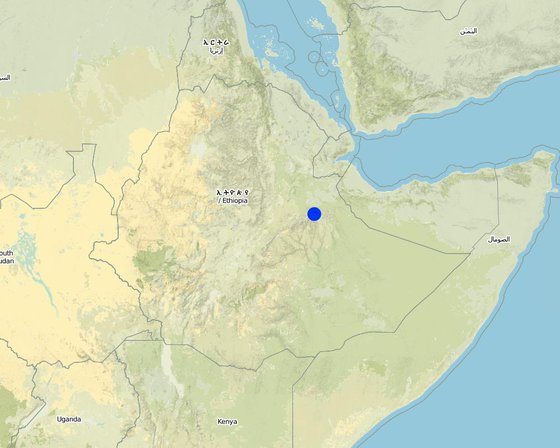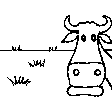DireDawaTraditional Checkdam
(埃塞俄比亚)
Chiba
描述
It is a stone wall built across a gully at a given interval to trap moisture and sediment for crop production.
It is an enbankment placed in the gully. It is constructed with stones. The purpose is to conserve and retain runoff coming from upslopes. It is intended to trap sediment running from slopes. It converts gully land into cultivated. The establishment starts with a given height of stone wall which is increased every year as the need comes and when sediment fills up. It is essentially water harvesting practice and is very suitable in areas where moisture stress is high. At present new design and layout elements have been included to improve durability of structures and efficiency to store more water and soils. Top soils eroded from upper catchments and sedimented by the checkdams. Maintenance is made every year to repair breaks and additional height is given for the checkdams.
地点

地点: Legedon, Dire Dawa, 埃塞俄比亚
分析的技术场所数量:
技术传播: 均匀地分布在一个区域 (approx. 10-100 平方千米)
在永久保护区?:
实施日期: 50多年前(传统)
介绍类型
-
通过土地使用者的创新
-
作为传统系统的一部分(> 50 年)
-
在实验/研究期间
-
通过项目/外部干预
主要目的
-
改良生产
-
减少、预防、恢复土地退化
-
保护生态系统
-
结合其他技术保护流域/下游区域
-
保持/提高生物多样性
-
降低灾害风险
-
适应气候变化/极端天气及其影响
-
减缓气候变化及其影响
-
创造有益的经济影响
-
创造有益的社会影响
土地利用
-
农田
- 一年一作: 谷物类 - 玉米, 谷类 - 高粱, 豆科牧草和豆类 - 其他, 豆科牧草和豆类 - 大豆, chat, oxen plough
- 多年一作(非木材)
- 乔木与灌木的种植: 柑橘属, 咖啡,露天种植, 芒果、山竹果、番石榴, 木瓜, prunus
每年的生长季节数: 1
采用间作制度了吗?: 是
-
牧场
- 半游牧畜牧业
- Stall feeding: Very common during crop growing season
供水
土地退化相关的目的
-
防止土地退化
-
减少土地退化
-
修复/恢复严重退化的土地
-
适应土地退化
-
不适用
解决的退化问题
-
土壤水蚀 - Wt:表土流失/地表侵蚀 , Wg:冲沟侵蚀/沟蚀 , Wr:河岸侵蚀
技术建立与维护:活动、投入和费用
投入和成本的计算
- 计算的成本为:
- 成本计算使用的货币:Birr
- 汇率(换算为美元):1 美元 = 8.6 Birr
- 雇用劳工的每日平均工资成本:1.00
技术建立活动
-
land preparation (时间/频率: during early rains)
-
formation of bench terrace (时间/频率: dry season)
-
manuring (时间/频率: dry season 1st application)
-
planting/pitting (时间/频率: during rains 2nd application)
-
stone collection (时间/频率: off farming season/dry season)
-
layout, digging foundation (时间/频率: off farming season/dry season)
-
shaping stone (时间/频率: off farming season/dry season)
-
placing of stone (时间/频率: off farming season/dry season)
-
interlocking stone (时间/频率: off farming season/dry season)
-
giving shape (时间/频率: off farming season/dry season)
技术建立的投入和成本
| 对投入进行具体说明 |
单位 |
数量 |
单位成本 (Birr) |
每项投入的总成本 (Birr) |
土地使用者承担的成本% |
|
劳动力
|
| Labour |
ha |
1.0 |
406.0 |
406.0 |
|
|
植物材料
|
| Seeds |
ha |
1.0 |
23.0 |
23.0 |
|
| 技术建立所需总成本 |
429.0 |
|
| 技术建立总成本,美元 |
49.88 |
|
技术维护活动
-
land preparation (时间/频率: April / once)
-
planting (时间/频率: April, June / once)
-
weeding and cultivation (时间/频率: June/August / twice)
-
repair in break stone walls (时间/频率: dry season /as need arises)
-
increasing heights & length of stone walls (side ways) (时间/频率: while cultivating /as need arises)
-
repair break in the check (时间/频率: dry period/annual)
-
raising the height (时间/频率: dry period/annual)
-
increasing the length (时间/频率: dry period/annual)
技术维护的投入和成本
| 对投入进行具体说明 |
单位 |
数量 |
单位成本 (Birr) |
每项投入的总成本 (Birr) |
土地使用者承担的成本% |
|
劳动力
|
| Labour |
ha |
1.0 |
40.0 |
40.0 |
|
|
植物材料
|
| Seeds |
ha |
1.0 |
23.0 |
23.0 |
|
| 技术维护所需总成本 |
63.0 |
|
| 技术维护总成本,美元 |
7.33 |
|
自然环境
年平均降雨量
-
< 250毫米
-
251-500毫米
-
501-750毫米
-
751-1,000毫米
-
1,001-1,500毫米
-
1,501-2,000毫米
-
2,001-3,000毫米
-
3,001-4,000毫米
-
> 4,000毫米
关于气候的规范
以毫米为单位计算的年平均降雨量:593.0
斜坡
-
水平(0-2%)
-
缓降(3-5%)
-
平缓(6-10%)
-
滚坡(11-15%)
-
崎岖(16-30%)
-
陡峭(31-60%)
-
非常陡峭(>60%)
海拔
-
0-100 m a.s.l.
-
101-500 m a.s.l.
-
501-1,000 m a.s.l.
-
1,001-1,500 m a.s.l.
-
1,501-2,000 m a.s.l.
-
2,001-2,500 m a.s.l.
-
2,501-3,000 m a.s.l.
-
3,001-4,000 m a.s.l.
-
> 4,000 m a.s.l.
土壤深度
-
非常浅(0-20厘米)
-
浅(21-50厘米)
-
中等深度(51-80厘米)
-
深(81-120厘米)
-
非常深(> 120厘米)
土壤质地(表土)
-
粗粒/轻(砂质)
-
中粒(壤土、粉土)
-
细粒/重质(粘土)
土壤质地(地表以下>20厘米)
-
粗粒/轻(砂质)
-
中粒(壤土、粉土)
-
细粒/重质(粘土)
水质(未处理)
-
良好饮用水
-
不良饮用水(需要处理)
-
仅供农业使用(灌溉)
-
不可用
应用该技术的土地使用者的特征
非农收入
-
低于全部收入的10%
-
收入的10-50%
-
> 收入的50%
个人或集体
-
个人/家庭
-
团体/社区
-
合作社
-
员工(公司、政府)
每户使用面积
-
< 0.5 公顷
-
0.5-1 公顷
-
1-2 公顷
-
2-5公顷
-
5-15公顷
-
15-50公顷
-
50-100公顷
-
100-500公顷
-
500-1,000公顷
-
1,000-10,000公顷
-
> 10,000公顷
土地所有权
-
州
-
公司
-
社区/村庄
-
团体
-
个人,未命名
-
个人,有命名
采用和适应
在所有采用这种技术的人当中,有多少人在没有获得物质奖励的情况下采用了这种技术?
-
0-10%
-
11-50%
-
51-90%
-
91-100%
最近是否对该技术进行了修改以适应不断变化的条件?
什么样的变化条件?
-
气候变化/极端气候
-
不断变化的市场
-
劳动力可用性(例如,由于迁移)
结论和吸取的教训
长处: 土地使用者的观点
-
conserve moisture
-
increases yield
长处: 编制者或其他关键资源人员的观点
-
high efficiency for storing soil and water,
How can they be sustained / enhanced? frequent maintenanace and upgrading
-
durable
-
forms bench fast
弱点/缺点/风险: 土地使用者的观点如何克服
弱点/缺点/风险: 编制者或其他关键资源人员的观点如何克服
参考文献
审查者
-
Fabian Ottiger
-
Alexandra Gavilano
实施日期: May 30, 2011
上次更新: Sept. 10, 2019
资源人
-
Daniel Danano - SLM专业人员
-
Million Ajire Tesema - SLM专业人员
文件编制者
机构
- Food and Agriculture Organization of the United Nations (FAO) - 意大利
项目





